(via TheNewswire)
The Project is currently under option (the “Option”) with Standard Uranium Ltd. (the “Optionor”)an arms-length company listed on the
Highlights:
Uranium Mineralization Confirmed:Analytical results from the winter 2024 drill program at the Project confirmed highly anomalous uranium in drill holes ATL-24-002, ATL-24-004A, and ATL-24-005A, coinciding with prospective structural zones and favorable alteration includingdravite-rich clays
Sandstone Basement-Hosted Uranium:Multiple zones of elevated uranium linked to the sub-
Athabasca unconformity and basement structural zones were intersected, indicating a uranium-fertile system.Uranium Pathfinders:Several key uranium pathfinder elements are present in anomalous quantities in multiple drill holes, providing vectoring information for future programs. Intersections of dravitic-clay associated with structural zones has been confirmed in drill holes ATL-24-002, ATL-24-004A, and ATL-24-005A.
Verified Targets:Massive structural disruption confirmed in the sandstone column and multiple wide (10 metres) brittle-reactivated graphitic shear zones confirm the main interpreted electromagnetic (“EM”) corridor on the western claim block which was not reached by previous operators. The inaugural program results have confirmed the Company’s exploration thesis on the Project, highlighting a uranium-fertile system with several kilometres of still untested strike length across the Project.
Follow Up Targets Next Steps:
Atlantic holds significant upside for discovery along the untested portions of the E-W conductor system. Supplementary geophysical surveys over the central claim blocks are currently being planned and will provide further target areas for phase II and III drilling, along with the additional untested gravity low anomalies on the western block identified in 2022.
“The intensity and scale of the dravite alteration in combination with the confirmed elevated uranium has me very encouraged with this modestly size initial drilling on Atlantic” says
“I am extremely excited with the drill results of this first phase” says
The
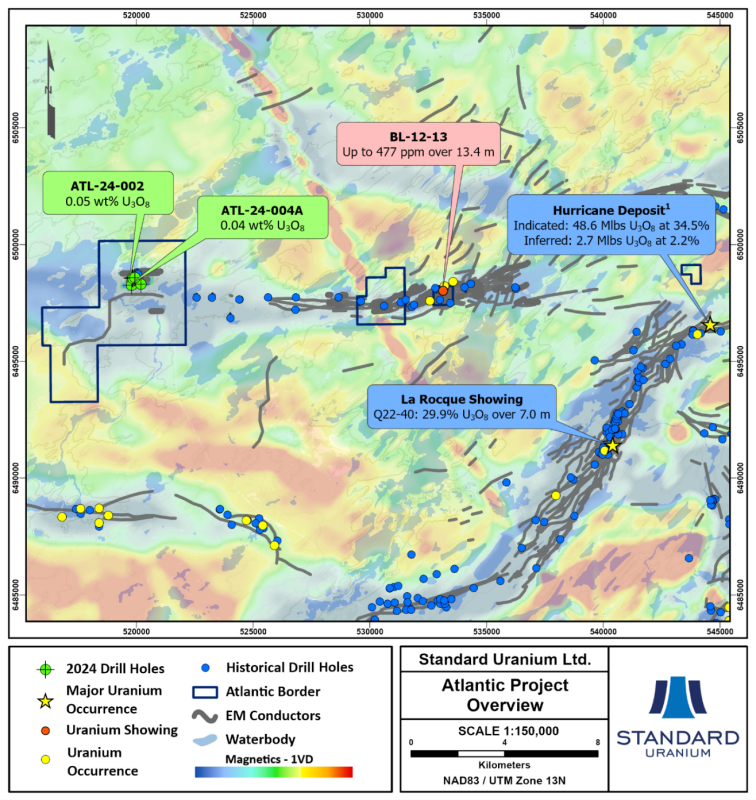
Click Image To View Full Size
Figure1. Regional summary map of the
Winter 2024 Drill Program Analytical Highlights:
The winter 2024 drill program comprised 3,316 metres of diamond drilling across 5 drill holes (Table 1). Inaugural drilling intersected the key characteristics of a uranium-bearing mineralized system in previously untested “Target Area A” (Figure 2), confirming the presence of a significant graphitic fault system in the basement rock linked touranium mineralization and prospective hydrothermal alteration at the unconformity and in the basement rock. Uranium analytical highlights are summarized in Table 2 and anomalous uranium pathfinder elements highlights are summarized in Table 3.
The highly prospective drilling results are visually summarized in schematic cross-sections highlighting dravite alteration, structure, and uranium results intersected during the inaugural drill program in Figures 3 and 4.
The drill program was designed to follow up on highly anomalous uranium results returned from drill hole BL-16-32, in addition to testing the newly outlined gravity lows defined by the 2022 ground survey. On the western
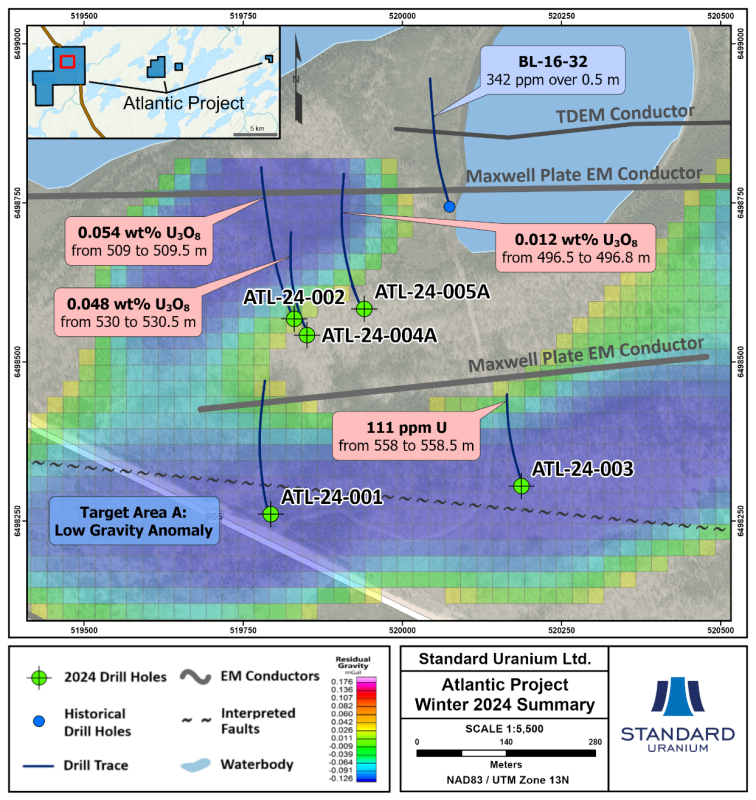
Click Image To View Full Size
Figure2. Map of the western
Table1.
DDH | Easting | Northing | Elevation (m.a.s.l.) | Azimuth (°) | Dip (°) | EOH (m) |
ATL-24-001 | 519790 | 6498261 | 412 | 344.80 | -69 | 599 |
ATL-24-002 | 519828 | 6498570 | 394 | 336.90 | -67 | 641 |
ATL-24-003 | 520190 | 6498305 | 396 | 338.20 | -74 | 588 |
ATL-24-004* | 519851 | 6498546 | 388 | 336.20 | -74 | 60 |
ATL-24-004A | 519851 | 6498546 | 388 | 336.20 | -74 | 657 |
ATL-24-005* | 519936 | 6498584 | 398 | 335.90 | -69 | 111 |
ATL-24-005A | 519936 | 6498584 | 398 | 336.40 | -69 | 660 |
* Restarted due to difficult ground conditions.
Table2.
DDH | From (m) | To (m) | Width (m) | Lithology | Uranium (partial, ppm) | U3O8(wt%) |
ATL-24-001 | 590.0 | 590.1 | 0.1 | Basement | 24.6 | - |
ATL-24-002 | 508.5 | 509.0 | 0.5 | Sandstone | 93.1 | 0.015 |
509.0 | 509.5 | 0.5 | 448 | 0.054 | ||
509.5 | 510.0 | 0.5 | 52.8 | 0.008 | ||
ATL-24-003 | 558.0 | 558.5 | 0.5 | Basement | 111 | - |
ATL-24-004A | 491.0 | 491.5 | 0.5 | Sandstone | 16.6 | - |
530.0 | 530.5 | 0.5 | Basement | 274 | 0.048 | |
544.0 | 544.5 | 0.5 | 88.2 | 0.014 | ||
544.5 | 545.0 | 0.5 | 109 | 0.015 | ||
549.0 | 549.5 | 0.5 | 128 | - | ||
549.5 | 550.0 | 0.5 | 120 | 0.018 | ||
ATL-24-005A | 492.5 | 493.0 | 0.5 | Sandstone | 41.2 | 0.008 |
493.0 | 493.5 | 0.5 | 44.7 | 0.007 | ||
494.5 | 495.0 | 0.5 | 64.2 | 0.01 | ||
495.0 | 495.5 | 0.5 | 17.4 | 0.002 | ||
495.5 | 496.0 | 0.5 | 13 | 0.002 | ||
496.0 | 496.5 | 0.5 | 44.4 | 0.006 | ||
496.5 | 496.8 | 0.3 | 82.7 | 0.012 |
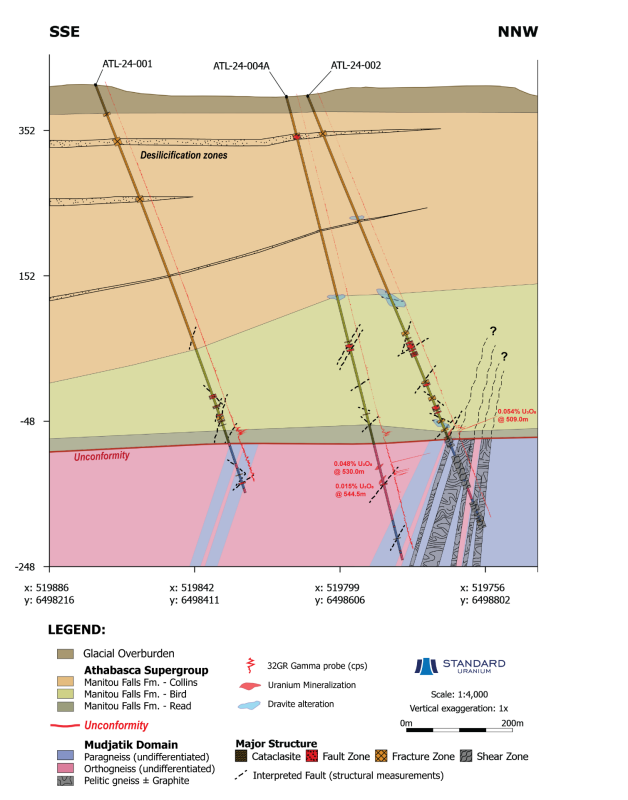
Click Image To View Full Size
Figure3. Schematic cross-section of drill holes ATL-24-001, ATL-24-002, and ATL-24-004A, facing west. Drill hole intersections of uranium, dravite alteration, and structure are highlighted.
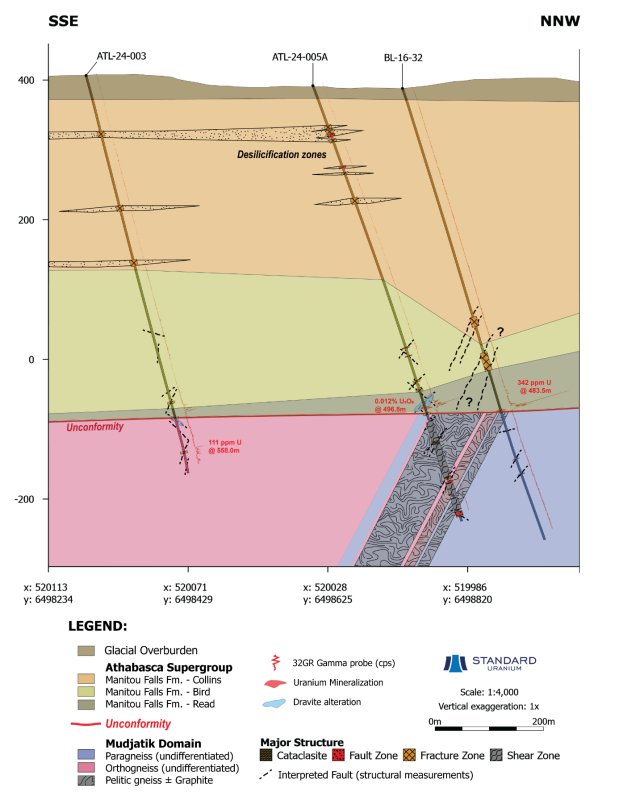
Click Image To View Full Size
Figure4. Schematic cross-section of drill holes ATL-24-003, ATL-24-005A, and historical drill hole BL-16-32 (Denison Mines), facing west. Drill hole intersections of uranium, dravite alteration, and structure are highlighted.
Table 3.
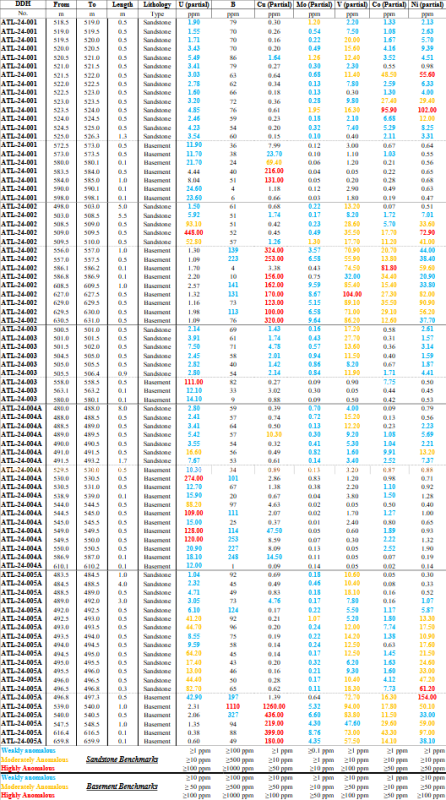
Click Image To View Full Size
Samples collected for analysis were sent to
Samples containing clay alteration were sent to
1The Company considers radioactivity readings greater than 300 counts per second (cps) to be “anomalous”.
2The Company considers uranium mineralization with concentrations greater than 1.0 wt% U3O8to be “high-grade”.
3Natural gamma radiation in diamond drill core reported in this news release was measured in counts per second (cps) using a handheld RS-125 super-spectrometer and verified using a down-hole
The scientific and technical information contained in this news release, including the sampling, analytical and test data underlying the technical information contained in this news release, has been reviewed, verified and approved by Mr.
About
Atco is a junior exploration mining company focused on exploring for green energy metals throughout
For further information contact:
Email:info@atcomining.com
Telephone: (604) 681-0084
www.atcomining.com
Neither the Canadian Securities Exchange nor its Regulation Services Provider (as that term is defined in the policies of the Canadian Securities Exchange) accepts responsibility for the adequacy or accuracy of this news release. The Canadian Securities Exchange has not in any way approved nor disapproved the contents of this news release.
FORWARD LOOKING STATEMENTS:
Certain information in this news release may contain forward-looking statements that involve substantial known and unknown risks and uncertainties. Forward-looking statements are often identified by terms such as “will”, “may”, “should”, “anticipate”, “expects” and similar expressions. All statements other than statements of historical fact included in this news release are forward-looking statements that involve risks and uncertainties. There can be no assurance that such statements will prove to be accurate and actual results and future events could differ materially from those anticipated in such statements. Important factors that could cause actual results to differ materially from the Company’s expectations are detailed from time to time in the filings made by the Company with securities regulations. The reader is cautioned that assumptions used in the preparation of any forward-looking information may prove to be incorrect. Events or circumstances may cause actual results to differ materially from those predicted, as a result of numerous known and unknown risks, uncertainties, and other factors, many of which are beyond the control of the Company. The reader is cautioned not to place undue reliance on any forward-looking information. Such information, although considered reasonable by management at the time of preparation, may prove to be incorrect and actual results may differ materially from those anticipated. Forward-looking statements contained in this news release are expressly qualified by this cautionary statement. The forward-looking statements contained in this news release are made as of the date of this news release and the Company disclaims any intention or obligation to update or revise such information, except as required by applicable law.
Copyright (c) 2024 TheNewswire - All rights reserved.
Copyright (c) 2024 TheNewswire - All rights reserved., source

